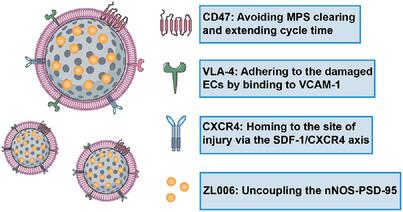Our official English website, www.x-mol.net, welcomes your feedback! (Note: you will need to create a separate account there.)
Reduction of Oxidative Stress and Excitotoxicity by Mesenchymal Stem Cell Biomimetic Co-Delivery System for Cerebral Ischemia-Reperfusion Injury Treatment
Small ( IF 13.0 ) Pub Date : 2024-07-01 , DOI: 10.1002/smll.202401045 Qi Zhang 1 , Shengnan Li 1 , Hua Chen 2 , Jiaqing Yin 1 , Yuqin Chen 1 , Linfeng Liu 1 , Weichong He 1 , Zhiyi Min 1 , Yue Gong 1 , Jiangna Xu 1 , Kefan Song 1 , Wei Lv 3 , Hongliang Xin 1
Small ( IF 13.0 ) Pub Date : 2024-07-01 , DOI: 10.1002/smll.202401045 Qi Zhang 1 , Shengnan Li 1 , Hua Chen 2 , Jiaqing Yin 1 , Yuqin Chen 1 , Linfeng Liu 1 , Weichong He 1 , Zhiyi Min 1 , Yue Gong 1 , Jiangna Xu 1 , Kefan Song 1 , Wei Lv 3 , Hongliang Xin 1
Affiliation

|
A cerebral ischemia-reperfusion injury is ensued by an intricate interplay between various pathological processes including excitotoxicity, oxidative stress, inflammation, and apoptosis. For a long time, drug intervention policies targeting a single signaling pathway have failed to achieve the anticipated clinical efficacy in the intricate and dynamic inflammatory environment of the brain. Moreover, inadequate targeted drug delivery remains a significant challenge in cerebral ischemia-reperfusion injury therapy. In this study, a multifunctional nanoplatform (designated as PB-006@MSC) is developed using ZL006-loaded Prussian blue nanoparticles (PBNPs) camouflaged by a mesenchymal stem cell (MSC) membrane (MSCm). ZL006 is a neuroprotectant. It can be loaded efficiently into the free radical scavenger PBNP through mesoporous adsorption. This can simultaneously modulate multiple targets and pathways. MSCm biomimetics can reduce the nanoparticle immunogenicity, efficiently enhance their homing capability to the cerebral ischemic penumbra, and realize active-targeting therapy for ischemic stroke. In animal experiments, PB-006@MSC integrated reactive oxygen species (ROS) scavenging and neuroprotection. Thereby, it selectively targeted the cerebral ischemic penumbra (about fourfold higher accumulation at 24 h than in the non-targeted group), demonstrated a remarkable therapeutic efficacy in reducing the volume of cerebral infarction (from 37.1% to 2.3%), protected the neurogenic functions, and ameliorated the mortality.
中文翻译:

间充质干细胞仿生共传递系统减少氧化应激和兴奋性毒性治疗脑缺血再灌注损伤
脑缺血再灌注损伤是由各种病理过程之间复杂的相互作用引起的,包括兴奋性毒性、氧化应激、炎症和细胞凋亡。长期以来,针对单一信号通路的药物干预政策在大脑复杂、动态的炎症环境中未能达到预期的临床疗效。此外,靶向药物递送不足仍然是脑缺血再灌注损伤治疗中的重大挑战。在这项研究中,使用由间充质干细胞(MSC)膜(MSCm)伪装的负载ZL006的普鲁士蓝纳米粒子(PBNP)开发了多功能纳米平台(指定为PB-006@MSC)。 ZL006 是一种神经保护剂。它可以通过介孔吸附有效地负载到自由基清除剂PBNP中。这可以同时调节多个目标和途径。 MSCm仿生可以降低纳米颗粒的免疫原性,有效增强其对脑缺血半暗带的归巢能力,实现缺血性脑卒中的主动靶向治疗。在动物实验中,PB-006@MSC 整合了活性氧 (ROS) 清除和神经保护作用。因此,它选择性地靶向脑缺血半暗带(24小时内的蓄积量比非靶向组高约四倍),在减少脑梗塞体积(从37.1%至2.3%)、保护神经源性神经元方面表现出显着的治疗效果。功能,并降低死亡率。
更新日期:2024-07-01
中文翻译:

间充质干细胞仿生共传递系统减少氧化应激和兴奋性毒性治疗脑缺血再灌注损伤
脑缺血再灌注损伤是由各种病理过程之间复杂的相互作用引起的,包括兴奋性毒性、氧化应激、炎症和细胞凋亡。长期以来,针对单一信号通路的药物干预政策在大脑复杂、动态的炎症环境中未能达到预期的临床疗效。此外,靶向药物递送不足仍然是脑缺血再灌注损伤治疗中的重大挑战。在这项研究中,使用由间充质干细胞(MSC)膜(MSCm)伪装的负载ZL006的普鲁士蓝纳米粒子(PBNP)开发了多功能纳米平台(指定为PB-006@MSC)。 ZL006 是一种神经保护剂。它可以通过介孔吸附有效地负载到自由基清除剂PBNP中。这可以同时调节多个目标和途径。 MSCm仿生可以降低纳米颗粒的免疫原性,有效增强其对脑缺血半暗带的归巢能力,实现缺血性脑卒中的主动靶向治疗。在动物实验中,PB-006@MSC 整合了活性氧 (ROS) 清除和神经保护作用。因此,它选择性地靶向脑缺血半暗带(24小时内的蓄积量比非靶向组高约四倍),在减少脑梗塞体积(从37.1%至2.3%)、保护神经源性神经元方面表现出显着的治疗效果。功能,并降低死亡率。






































 京公网安备 11010802027423号
京公网安备 11010802027423号